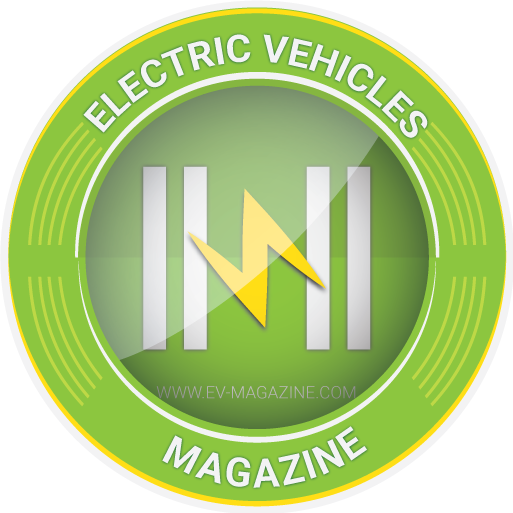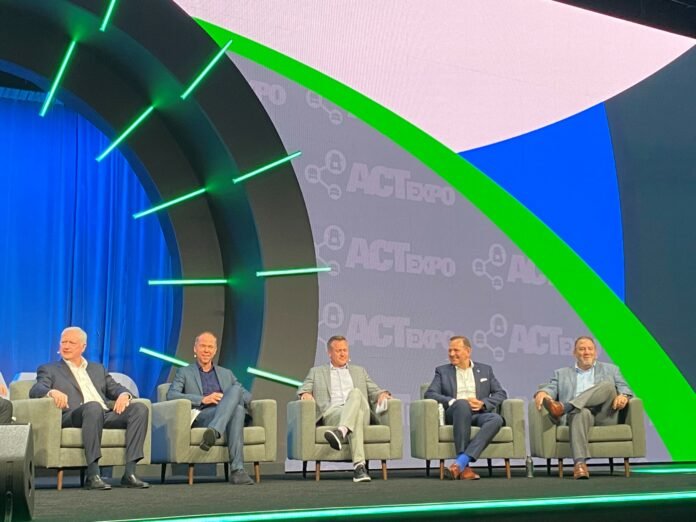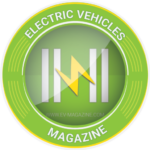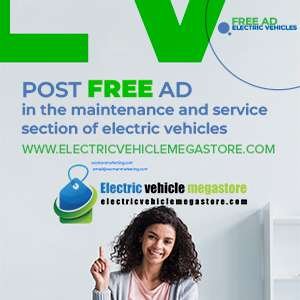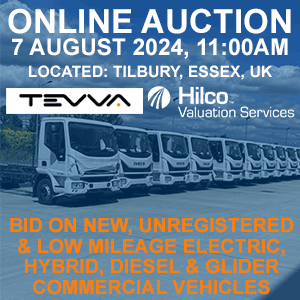It was a peculiar sight – the leaders of five truck OEMs sharing a stage. And an equally peculiar experience, that they were mostly in agreement on all the issues discussed at ACT Expo’s panel discussion.
Top of mind for all the executives on the panel was the need to continue pushing for more electric vehicle charging infrastructure. And that’s not just limited to the chargers themselves.
John O’Leary, Mathias Carlbaum, Jason Skoog, Peter Voorhoeve, and Jonathan Randall share a stage at ACT Expo. (Photo: James Menzies)
“Infrastructure is such a broad term,” said Jonathan Randall, president of Mack Trucks North America. He noted it extends beyond chargers, to the grid and how electricity passes from the grid to the point of charge. That’s something truck manufacturers have not traditionally had to be concerned with. Now, he said, discussions with customers around infrastructure requirements come before any talk about selling the truck itself.
John O’Leary, president of Daimler Truck North America, agreed that charging infrastructure deployment was not advancing rapidly enough and that OEMs have since come together under the PACT collaboration.
“We want to participate in trying to solve that infrastructure problem,” he said. “If left to its own devices, it was not happening fast enough.”
“We cannot talk about infrastructure enough,” agreed Jason Skoog, general manager of Peterbilt and vice-president of Paccar. He went on to urge attendees to bring up charging infrastructure needs with decision makers at any opportunity possible.
EV adoption slowing
OEMs also agreed that the pace of electric truck adoption is slowing, partly due to the lack of public charging infrastructure. O’Leary noted that five years ago “We didn’t know what we were doing, we just knew we had to do something.”
There have been some positive surprises, such as the collaboration between OEMs on charging infrastructure and fuel cell development. “The collaboration we all have as companies globally and within North America is something none of us would’ve foreseen,” he said. “It brought us closer together in terms of developing technology and joint ventures.”
However, he acknowledged “I thought the ramp-up curve wouldn’t have flattened out as it has. We didn’t necessarily foresee the necessity of infrastructure and limiting factors outside our control. We felt if we built it they would come, and found out there were more complexities involved.”
Randall said the technology is advancing as hoped, but adoption is lagging.
“Our exuberance was way ahead of the market’s willingness to accept that technology and adopt it,” he said of electrification. “We forecasted a steeper adoption curve than what we’ve seen.”
He acknowledged the industry is not yet at parity, where a diesel truck can be swapped out one-for-one with an electric vehicle in most applications. “We’re not there, but we’re striving to get there,” he said.
Even so, all the executives agreed fleets need to begin familiarizing themselves with zero emission truck technology or risk being left behind.
Mathias Carlbaum, president and CEO of Navistar, encouraged fleets to carve out a small portion of their fleet that’s viable to electrify and go from there.
“Is it 5% [of your fleet],” he asked. “Where can we start? Where does it make sense in your routes, the grid, the state, the price of electricity? Those conversations are where the big value add is happening. If you don’t join this over time, it might be too late.”
“You can’t wait,” agreed Skoog. “If you are not trying what’s available today, you are going to be behind the adoption curve. At least try one. You’ve got to understand, how can I make this work in my application because this is reality, it’s not going away. It’s incumbent on everybody running a fleet to simply try it.”
Randall said fleets must find a piece of their operation in which zero emissions trucks will work today, or reconfigure their operations to make it work.
Each of the OEMs said their manufacturing processes have been adapted to produce electric vehicles on the same assembly lines as their diesel trucks.
“It’s a different powertrain that gets set,” said Skoog.
In Daimler’s case, electric trucks are increasingly being used for inbound logistics at those plants.
“We thought there were significant learnings to be had there as customers from a cost perspective and operational standpoint,” said O’Leary. “We could put ourselves in the shoes of our customers when they start talking about lack of total cost of ownership and things like that. We want to be able to look them in the eye and say, we understand.”
Diesel remains dominant
Panelists also agreed diesel isn’t going anywhere anytime soon.
“The diesel business is paying for all of this, quite honestly,” O’Leary said, adding 99% of all trucks sold are still diesel-powered.
But Peter Voorhoeve, president of Volvo Trucks North America, said much can be done to decarbonize even with diesel-fueled trucks.
“If we improve fuel efficiency on diesel engines, the impact of that on the climate is many, many times bigger than the introduction of electric vehicles,” he said, adding the current diesel engine is 60 times cleaner than those available at the beginning of this century.
“Internal combustion engines will continue to exist after 2050,” he said, adding “We can ask ourselves what kind of fuel do we use? Will it be fossil-free fuel? The internal combustion engine will gets to its 150th birthday, 200th birthday maybe.”
“The diesel business is not dead,” Skoog agreed.
Carlbaum added “We just have to bring the right solution at the right moment to the customer.” He said diesel engine efficiency has improved by 1% a year on average over the past 30 years.
Source link
#Truck #OEMs #aligned #path #decarbonization
